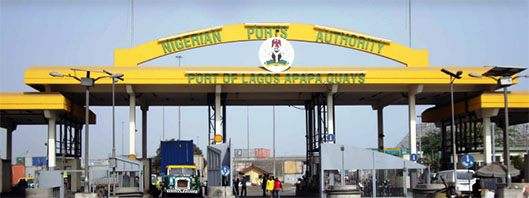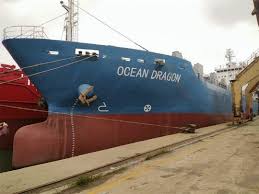
There are seven major seaports in Nigeria. They are: Lagos Port Complex, Tin Can Island Port, Calabar port, Onne port, Port Harcourt port and Delta ports. The latest of them is the Lekki port in Lagos.
Lagos port (also called Apapa Quay) is the biggest port in the country, in terms of both land area and volumes of cargo handled.
The port spans more than 80 hectares and boasts a four-wheeled gate measuring eight metres for receiving oversized cargo, giving it an edge over other Nigerian ports. It has two logistics bases namely Eko Support Services Ltd. and Lagos Deep Offshore Logistics, containing customs bonded warehouses and terminal buildings.
Lagos Port Complex houses five private terminals operated by AP Moller, ENL Consortium Limited, Apapa Bulk Terminal, Greenview Development Nigeria Ltd and Lilypond Inland Terminal. These specialised facilities have more than 10 berths for handling cereals, grains, machinery, construction material, and perishable items like foodstuff, minerals, fertilisers, flour, salt, sugar etc. Two flour mills and a processing plant are present on the port premises, close to the bulk terminals.
On its part, the Tin Can Island port is situated west of Apapa near the Lagos Port Complex. It’s the second busiest port in Nigeria, it was established in 1975 when economic activity, especially international trade increased manifold, a consequence of the oil boom in Nigeria after the civil war ended and reconstruction began. Growing import and export trade led to congestion of the Lagos port, hence another facility was constructed at the Tin Can Island for diverting excess cargo.
The Calabar port became operational in 1979 and lies 45 nautical miles upstream from the Fairway buoy. A multi-purpose port, it is managed by Nigeria Ports Authority and consists of three terminals operated by ECM Terminal Ltd, INTELS Nigeria Ltd and Shoreline Logistics Nigeria Limited. It requires regular dredging to maintain a 7.5 m draught. Approximately 240,000 tonnes of general cargo, 10,000 TEUs and 9,600,000 tonnes of crude oil are handled at the port annually.
Undoubtedly the most modern before the coming of Lekki port in Lagos, Onne port lies on the River Bonny along the creek of Ogu. It was established as a free port zone to serve the oil and gas sector of West Africa. The refurbished port can accommodate the latest generation-ocean going vessels and consists of a Federal Ocean Terminal and the Federal Lighter Terminal. The former has four wharves and the latter contains eleven berths.
The Warri port was constructed in the late 1980s to serve the west delta region and attract oil companies. Lying between Lagos and Onne port, it enjoys an advantageous position and was declared a Free Zone in 2011.
The last and the oldest port; Harcourt Port is located in the Gulf of Guinea, also called the Rivers port complex in eastern Nigeria. The port entrance requires regular dredging for maintaining a constant water depth. Harcourt is an important transhipment hub for Niger and Chad. It is also a railway terminus and a major Nigerian coal export harbour, handling 810,000 tonnes of cargo annually.
The multipurpose facility acts as a mother port for numerous jetties lying close to the port premises. It is strategically positioned in one of the world’s biggest crude oil production zones.
From the brief above about these ports, there is no doubt about the fact that they are old and they require upgrading. Apart from Onne port and now Lekki port, other port are in need of upgrading, especially in the area of infrastructure.
Worst hit is Port Harcourt and Tin Can ports, where there have been cases of failed quay walls and failed berths
On a general note, port infrastructure includes docks, piers, channel harbors and more. But, because the conditions from terminal to terminal within a port vary, the standard practice is for port authourities to maintain their infrastructure in the characteristic harsh marine environments.
In the light of the glaring decay of infrastructures over the years, maritime industry stakeholders have also raised the alarm about the state of the infrastructure in Nigerian seaports and lamented that they are fast decaying and threatening international trade in the country.
They also confirmed that the collapsed portions of some terminals in most of the ports are getting worse on a daily basis as no efforts are made to rehabilitate them.
From Lagos to Port Harcourt to Calabar and Delta port, the story of failed quay walls, and many dilapidated common user facilities testifies to long years of abandonment. The fact is: Tin Can Island Port and Apapa Port in Lagos, Onne Port in Rivers State and Escravos breakwaters in Warri Port and Calabar Port in Cross River have continued to cause setback for trade facilitation and hinder the much-anticipated growth and revenue generation of the Federal Government, on account of these failed port facilities.
We recall and acknowledged that the Managing Director, Nigerian Ports Authority (NPA), Mohammed Bello Koko, has severally called attention to this fact.
From findings, about 85 per cent of ports infrastructure in Nigeria are over 40 years old and need urgent attention. The truth is that NPA has been fixing these failures for a while and these palliative and remedial works are no more effective. These ports need total rehabilitation.
The above captures the need to urgently pay attention to the state of port infrastructures, the cost of which the management of the NPA has put at a whopping $800Million.
There are two funding options available to the government. It is either to approach international funding agencies or to ask the terminal operators to fund it and seek amortisation. The first option is attractive, but it is almost like asking the NPA to fund it. The only drawback in this option is that it would reduce NPA’s contributions to the Consolidated Revenue Fund (CRF) of the Federal Government, because of the terms of repayment of the loans.
We are not too convinced that the terminal operators will not take advantage of the option of asking them to fund the rehabilitation. We still remember the story of a similar arrangement in Onne port between the NPA and the concessionaire at that port. There were allegations and counter-allegations bordering on negation of terms and conditions.
The Federal Government will need to be decisive about the appalling situation of these ports. The terminal operators will keep using these facilities as they are and the infrastructure will keep deteriorating.
It is good that the Minister of Marine and Blue Economy; Mr Adegboyega Oyetola, has equally acknowledged that the ports need urgent rehabilitation.















